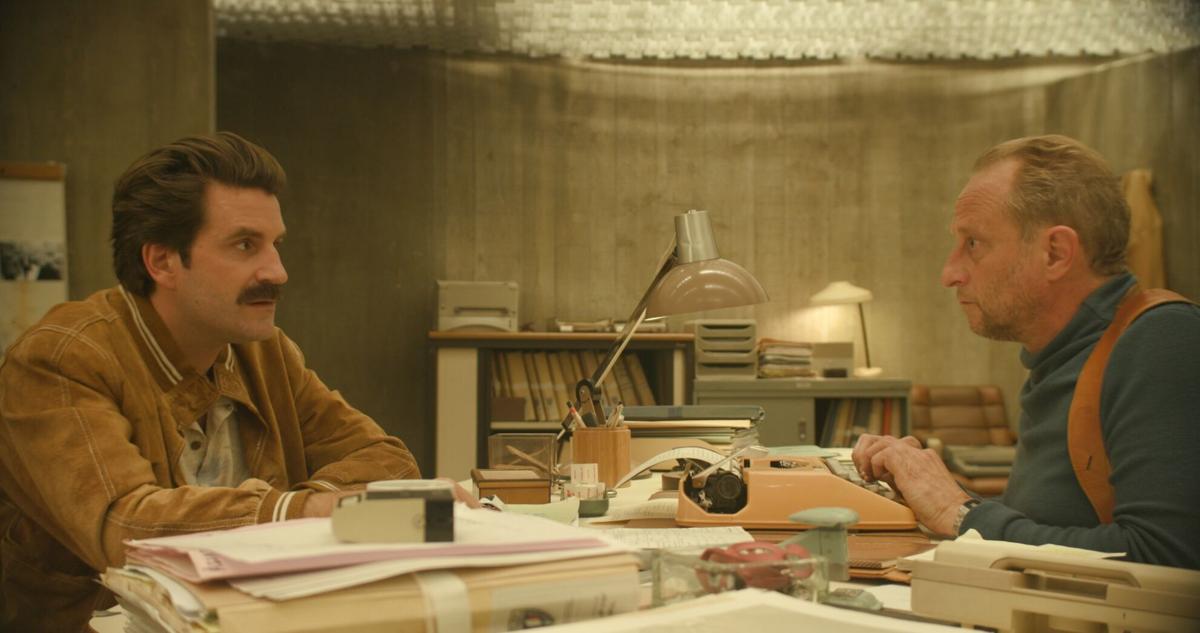By Chlotrudis Independent Film Society
Rating: 3.5 cats
Director: Quentin Dupieux
Starring: Anaïs Demoustier | Benoît Poelvoorde | Grégoire Ludig | Jacky Lambert | Jeanne Rosa | Marc Fraize | Orelsan | Philippe Duquesne | Vincent Grass

Original language title: Au poste!
Country: belgium, france
Year: 2021
Running time: 73
IMDB: https://www.imdb.com/title/tt7156222/reference
Chris says: “The ‘latest’ from filmmaker Quentin Dupieux actually precedes 2019’s DEERSKIN, having come out in France in 2018. Just receiving a US release now, it initially feels decidedly low concept coming from this director, as a cop (Benoît Poelvoorde) placidly interrogates a murder suspect (Grégoire Ludig) in the former’s office. Then, about 15 minutes in, something wacky occurs and the film gets progressively more absurd from there. Perhaps the talkiest Dupieux film to date, it’s confined to a few sets, which only heightens the narrative’s increasingly surreal, meta stance. And, not counting the credits, it’s mostly over in 65 minutes. Sharp but slight, it’s relatively accessible for Dupieux without diluting any of his weirdness. 3.5 cats
“(Currently playing at the Brattle’s Virtual Screening Room.)”
Michael says: “I really enjoyed this one. Dupieux has such an offbeat way of telling a story, and this one doesn’t really reveal itself fully until the end, so I won’t give anything away. As Chris states, what starts as a police interrogation, with maybe one or two hints that it’s a little quirky, end up as a bizarres examination of story-telling, or exposition. I really don’t know what else to say about it, but it’s fun and well worth a look at just over an hour. 4 cats”
Bob says: “Quentin Dupieux examines what it means to tell a story, especially to do so using the medium of film. C’est pour ça. Does the person listening to the story experience the same thing as the audience of the film? They’re the audience of the story, but they’re also a player in the film. How does that make their role different, if at all? Does the storyteller know what to expect from the experience of the listener? C’est pour ça.
“The film opens with what I think has to be a reference to Buñuel’s L’Age D’Or, in which a man is arrested (or at least chased by the police) under bizarre circumstances. Later on, we’ve got an even clearer homage to The Discreet Charm of the Bourgeoisie when the fourth wall in a scene becomes a theater curtain. C’est pour ça.
“There is a story here, believe it or not: a police detective is interrogating a man who claims to have just discovered a dead body when he just happened to be outside his apartment building. C’est pour ça. His nosy neighbor claims he went outside and came back in seven times that evening. There’s also a bit of evidence right by the body that suggests that the man’s story might not be completely true. C’est pour ça.
“During the telling of different parts of different stories, we’re presented with details that make us question the nature of communicating things that happened in the past: the person listening to the story seems to be aware of what the people watching the film can see. C’est pour ça. Can a person listening to a story get the omniscent perspective of the audience of the film? Is the audience’s perspective really omniscent, particularly when we know that this is a particular character’s version of a story? C’est pour ça. A character shows up in the story even though, at the time of the story, she and the main character haven’t met, but she starts asking him for details that haven’t been revealed to her in the present (is there a present?) yet. It’s his own fault for letting her know there are things she doesn’t know. C’est pour ça.
“Something happens during a break in the interrogation that gives our person of interest something he feels he definitely has to hide. This adds another layer of humor — a kind of absurd situation comedy layer — to the film, but it also makes us question the veracity of the story he’s telling. C’est pour ça. On top of that, other people’s stories are revealed to be false. Why should we believe anything? Why should they? C’est pour ça.”
Diane says: “Absurdity rules once again in filmmaker Dupieux’s little gift to his fans. It reminds me of the old short story ‘August Heat,’ in which an artist, out for a stroll, encounters a man who looks just like the subject of a sketch the artist has in his pocket: that of a man in a courtroom being sentenced. I agree with Michael that it’s an examination of story-telling, and perhaps our delight, as audience, in being taken in. Dupieux is also DP and employs the same palette and 1970s look (if I remember correctly) as his earlier RUBBER and DEERSKIN. 3 cats”
